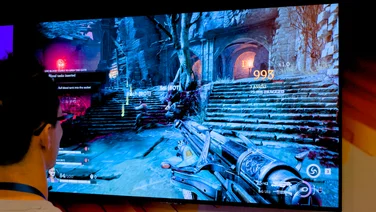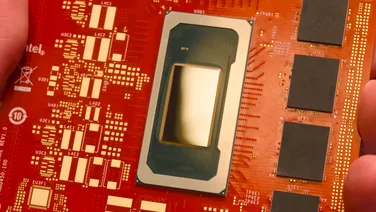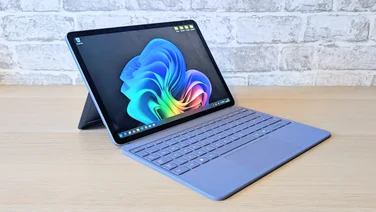To help us provide you with free impartial advice, we may earn a commission if you buy through links on our site. Learn more










- Sublime 3.1K OLED touchscreen
- Arrow Lake CPU delivers towering performance
- Space for two SSDs
- No support for 6GHz Wi-Fi
- Soldered RAM
- No Thunderbolt 4 / USB-C 4
Huawei was building a very nice mobile and laptop business until a US trade embargo put the kibosh on it accessing the latest generation of CPUs and operating systems from US companies like Intel and Google. You can still buy the excellent MateBook X Pro, but it runs on an Intel Meteor Lake CPU rather than the latest Lunar Lake or Arrow Lake silicon.
Huawei’s answer was to spin off its budget brand Honor as an independent entity, which so far, is working. Honor has already launched an impressive range of mobile phones, and now it’s the turn of the laptops to get the latest tech, starting with the launch of the MagicBook Pro 14 – Honor’s first laptop to feature a Core Ultra Series 2 CPU.
Honor MagicBook Pro 14: What you need to know
There is no part of the laptop market as brutally and ruthlessly competitive as the high-end compact. Customers expect high levels of performance, long battery life, tip-top levels of design and build-quality, cutting-edge display technology and a reasonable price. Building a class-cleading 14in compact and charging £2,000 for it is a waste of time when you can buy an entry level MacBook Air for under £1,000.
That’s why we are surrounded by such cracking devices as the Asus Zenbook 14 and Zenbook S16, the 14in Apple MacBook Pro and 13in MacBook Air, the Microsoft Surface Laptop 13in and the Samsung Galaxy Book5 Pro, to name but a few, and it’s why Dell’s not wholly unimpressive new 14 Plus doesn’t quite cut the mustard.










To enter this market and be competitive is no easy feat, but to enter it with a machine that leaps right to the top of the pile is worthy of a standing ovation. And that’s exactly what Honor has done with its new MagicBook Pro 14.
Price and competition
Configuration tested: 16-core, 5.4GHz Intel Core Ultra 9 285H CPU, 32GB RAM, 1TB SSD, 14.6in 3,120 x 2,080 OLED 120Hz display. Price when reviewed: £1,299
Honor’s website mentions two processor options: the Intel Core Ultra 5 225H
and Core Ultra 9 285H, as well as two colourways – grey and white. As far as I’ve been able to gather, the UK will only get the grey Core Ultra 9 model.
The standard list price for the MagicBook 14 is £1,299, which makes it a very good value, but until June 30th 2025, Honor is offering a £300 discount, taking it down to £999. At that price, it’s the laptop deal of the decade.
- The pick of the rival compact laptop crop is the Asus Zenbook S14. It’s a design classic, and the build quality matches the looks. It also has a sumptuous 2.8K 120Hz OLED touchscreen and exceptional battery life. Right now, Asus is selling the S14 for just £1,099
- The daddy of all compact laptops, the Apple MacBook Air, now has M4 power, and with prices starting at below £1,000 for the 13.6in model and £1,100 for the 15in version, it’s one of the more affordable options just as long as you can live with a 256GB SSD
- A little larger than the MagicBook and usually more expensive (though not at the time of writing, thanks to Asus offering a £400 discount) the Zenbook S16 is one of my favourite laptops of the last 12 months. It has a superb 16in OLED display, a powerful AMD Ryzen AI 9 chipset, while the looks and build quality are second to none
- Samsung is currently offering the 14in Galaxy Book5 Pro with a £300 discount, reducing the price from £1,499 to £1,199, which makes it worth a look. Its 120Hz 2.8K OLED display is impressive, as is the four-speaker sound system, and, unusually for a compact laptop, there’s space for two SSDs inside
Design and features
The MagicBook 15 is a handsome, sleek affair made largely from aluminium alloy. It feels very well put together and proved impressively resistant to any attempts to bend it. This is especially true of the lid, which boasts noticeably thin bezels of just 8mm at the top and bottom and folds back flat through 180 degrees.
Honor’s international website shows two colourways: StarryGrey and White. The former looks good, but the latter (according to Honor, it uses a “Pearlescent Electrophoresis” process for a “stunning leap in colour and texture”) makes the MagicBook a stunner. It’s a shame it’s not currently listed as an option on Honor’s UK site.










More important than any of that is the fact that the paint finish grey model I was sent to review refused to show fingerprints or grease stains – even after I picked it up after eating a bag of chips with my fingers.
At 1.39kg and 320 x 232mm, the 14.6in Magic Book sits slap bang between the 13.6in and 15.3in models of the MacBook Air in terms of size, although both the MacBooks are rather thinner than the Honor’s 17mm. For a 14.6in laptop, I’d describe it as impressively compact.
On the left side of the MagicBook, you’ll find two 10Gbits/sec USB-C ports, both of which support PD charging and DisplayPort video, along with an HDMI 2.1 port and a 3.5mm audio jack. On the opposite side, there are two USB-A ports rated at 5Gbits/sec.










So, points awarded for a good selection of ports. Points deducted for none of them being USB-C 4 or Thunderbolt 4 compliant.
Typically of laptops from Chinese manufacturers, the MagicBook’s SSD is divided into two partitions: a 200GB C: drive for Windows and the rest, and a D: drive for data. Just remember to save your files to the latter.
I’ll forgive the irritating division, though, because the Honor’s SSD, made by Yangtze Memory Technologies (a name new to me), is fast with sequential read and write speeds of 5,651MB/sec and 5,078MB/sec. Those results put it well ahead of its main rivals on raw speed.
To get inside the MagicBook, you’ll need a Torx screwdriver, but other than that it’s a simple job. The memory and wireless card are soldered to the motherboard, but there is space for a second M.2 2280 SSD, which means expanding the internal storage is as easy as can be.
The wireless card is the ageing Intel AX201, which means there’s no support for 6GHz Wi-Fi, and the Bluetooth version is stuck at 5.1. I don’t regard this as a dealbreaker, but Honor could have tried harder to have the MagicPro at least support Wi-Fi 6E if not Wi-Fi 7.
Honor bundles the MagicBook with its MagicRing content sharing and device connecting software, but you’ll need to be using a companion device like the Honor Pad 10 tablet, Honor Magic 7 Pro phone running Honor’s MagicOS, or an iPhone with the Honor Connect app to take full advantage.
Keyboard, touchpad and webcam
The MagicBook’s keyboard is conventional and, at first glance, looks similar to that of the Dell Plus 14 I tested recently, right down to the matte-finish keys and the fingerprint-enabled power button in the top right corner.
The keyboard deck is reasonably solid with no perceptible flex, unless you press down with abnormal severity. The keys have a smooth 1.5mm action and a firm end-stop. The two-stage white backlight works well, and there’s a keyboard Fn lock to force the function keys into media mode.










The 120 x 72mm touchpad is a little on the small side, given how much space is available below the keyboard; it could easily extend another 5mm in all directions, but otherwise it is pleasant to use. The surface of the touchpad is wholly smooth, with the plastic surface giving nothing away to the Mylar or glass-covered competition in terms of tactility. The click-action is clean, well-damped and quiet.
The 1080p webcam is a solid example of the breed that captures images that are crisp and colourful, if a little on the dim side.
Display and audio quality
The MagicBook Pro’s display is the best available on any compact laptop currently on the market.
The 14.6in 3,120 x 2,080 (that’s a 3:2 aspect ratio) panel has a pixel density of 257dpi (compared to the MacBook’s 224dpi), refreshes at 120Hz, and can achieve 495cd/m² in SDR mode and 720cd/m² in HDR. That’s an impressive set of numbers for a screen in a £1,300 laptop.










There is plenty of colour available, too. Natively, the panel is able to deliver 123% of the DCI-P3 gamut (equivalent to 174% of sRGB or 120% of AdobeRGB), which means there’s plenty of headroom for calibration.
It’s also highly accurate, with Delta E variances of just 0.9 against those same three profiles when selected in the display management section of the Honor control panel app. The display also has an eBook colour setting, which does a good job of imitating an E-paper display.










Uniquely in our experience at Expert Reviews, the MagicBook has a software toggle to disable the touchscreen function. Now, admittedly, we can’t think of a use for this feature, but that’s not to say there isn’t one.
As for audio, the stereo speakers are a little on the quiet side, only registering 70.4dBA on a sound meter from a pink noise source at 1m, but the sound is full, well-balanced and detailed with plenty of bass. Listening to the new, and altogether excellent, debut album from Annahstasia on the MagicBook was a pleasantly mellifluous experience.
Performance and battery life
The CPU inside the MagicBook is an Intel Arrow Lake Core Ultra 9 285H with 16 cores. It is considerably more powerful than the Meteor Lake second-generation Core Ultra processors to be found in most of the competition, as demonstrated by its high score of 424 in our 4K multimedia benchmark.
That puts the MagicBook streets ahead of the likes of the basic M4 MacBook Air and Asus Zenbook S14, and even a nose ahead of the likes of the Asus Zenbook S16 and M4 MacBook Pro.
The performance advantage the 285H lends to the MagicBook is underlined in the Cinebench R24 multi-core test, which delivered a result of 1,041 in the Honor compared to 928 in the AMD-powered Zenbook S16, 746 in the M4 MacBook Air and 616 in the Samsung Galaxy Book5 Pro.
Graphics performance is equally impressive, with the Arc 140T integrated GPU scoring 42,698 in the GeekBench 6 GPU (OpenCL) benchmark, more than 7,000 points clear of the closest competition.
Of course, if all that performance comes at the expense of excessively loud fans and short battery life, the MagicBook’s victory would be Pyrrhic at best, but even under heavy stress, the Honor runs reasonably quietly, and thanks to a large 92Wh battery, it can run for over 16 hours when unplugged.
Sixteen hours and ten minutes may not sound all that impressive when the best of the Snapdragon X and Lunar Lake competition can get close to the 20-hour mark, but the potent Arrow Lake CPU and 3.1K OLED screen were always going to count against the new Honor. And any laptop that can outlast a MacBook Air, even if only by 20 minutes, can hardly be said to do badly.
Honor MagicBook Pro 14: Verdict
When I first read the MagicBooks spec list, I was struck by the absence of 6GHz Wi-Fi and USB-C 4 or Thunderbolt ports. But now, I think I see what Honor is doing, as both those upgrades would make the MagicBook 14 more expensive, both in terms of hardware and licenses, but would deliver benefits that many, possibly the large majority of potential customers, are not all that concerned about. After all, my own laptop only has 5GHz Wi-Fi and 10Gbits/sec USB-C ports, and that causes me no problems.
Rather, Honor has spent money where it matters every time you use your laptop: on a superb OLED screen, a decent sound system, a powerful chipset, a big battery, and a fast and easily expandable storage system. Has Honor delivered the perfect combination of components and price with the MagicBook 14? I think it may have. It’s our new favourite laptop.
Honor MagicBook 14 Specifications
| Processor | Intel Core Ultra 9 Processor 285H |
| RAM | 32GB |
| Additional memory slots | No |
| Max. memory | 32GB |
| Graphics adapter | Intel Arc Graphics 140T |
| Graphics memory | Shared |
| Storage | 1TB |
| Screen size (in) | 14.6 |
| Screen resolution | 3,120 x 2,080 |
| Pixel density (PPI) | 257 |
| Screen type | OLED 120Hz |
| Touchscreen | Yes |
| Pointing devices | Touchpad |
| Optical drive | No |
| Memory card slot | No |
| 3.5mm audio jack | Yes |
| Graphics outputs | USB-C DP AltMode x 2 HDMI 2.1 x 1 |
| Other ports | USB-C 3.2 Gen 2 x 1, USB-A 3.2 Gen 1 x 2 |
| Web Cam | 1080p |
| Speakers | Stereo |
| Wi-Fi | Wi-Fi 6 |
| Bluetooth | Bluetooth 5.1 |
| NFC | Yes |
| Dimensions, mm (WDH) | 320 x 232 x 17mm |
| Weight (kg) – with keyboard where applicable | 1.39 |
| Battery size (Wh) | 92 |
| Operating system | Windows 11 Home |






